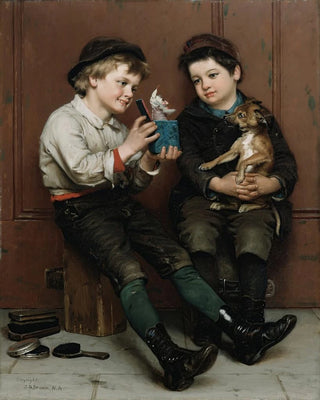Art print | A Surprise Party - John George Brown


View from behind

Frame (optional)
In the vibrant universe of art, certain works manage to capture the essence of fleeting moments, transforming ordinary instances into eternal memories. "A Surprise Party" by John George Brown is one of those creations that evokes an atmosphere of joy and wonder. Immersing oneself in this piece, the viewer is immediately transported to the heart of a celebration, where facial expressions and the dynamism of gestures tell a lively story. Brown, with his unparalleled talent, succeeds in capturing the nuances of human emotion, making every detail almost tangible. The light dancing on faces, the frozen bursts of laughter, all compose a scene that invites contemplation and escapism.
Style and uniqueness of the work
John George Brown's style is distinguished by a realistic approach, blended with an impressionist sensibility. In "A Surprise Party," he uses a palette of vibrant colors that evoke cheerfulness and conviviality of the event. The characters, carefully dressed, are depicted in natural poses, creating a lively and authentic atmosphere. The artist excels in rendering expressions; each smile and gaze seem to tell a personal story. The details, whether in clothing or accessories, are treated with exceptional meticulousness, reflecting his attention to the elements that make up the scene. This work, through its harmonious composition and masterful use of light, stands out as an emblematic example of late 19th-century art, capturing not only a moment but also a universal emotion.
The artist and his influence
John George Brown, born in 1831 in Liverpool, is a painter whose work has profoundly impacted the American artistic landscape. An immigrant to the United States, he quickly established himself as a master of genre painting, focusing on scenes of everyday life. His influence extends beyond his own creations, inspiring many contemporary and future artists with his innovative approach to light and color. Brown managed to establish a link between the tradition of European realism and new American trends, thus creating an artistic bridge that enriched the culture

Matte finish

View from behind

Frame (optional)
In the vibrant universe of art, certain works manage to capture the essence of fleeting moments, transforming ordinary instances into eternal memories. "A Surprise Party" by John George Brown is one of those creations that evokes an atmosphere of joy and wonder. Immersing oneself in this piece, the viewer is immediately transported to the heart of a celebration, where facial expressions and the dynamism of gestures tell a lively story. Brown, with his unparalleled talent, succeeds in capturing the nuances of human emotion, making every detail almost tangible. The light dancing on faces, the frozen bursts of laughter, all compose a scene that invites contemplation and escapism.
Style and uniqueness of the work
John George Brown's style is distinguished by a realistic approach, blended with an impressionist sensibility. In "A Surprise Party," he uses a palette of vibrant colors that evoke cheerfulness and conviviality of the event. The characters, carefully dressed, are depicted in natural poses, creating a lively and authentic atmosphere. The artist excels in rendering expressions; each smile and gaze seem to tell a personal story. The details, whether in clothing or accessories, are treated with exceptional meticulousness, reflecting his attention to the elements that make up the scene. This work, through its harmonious composition and masterful use of light, stands out as an emblematic example of late 19th-century art, capturing not only a moment but also a universal emotion.
The artist and his influence
John George Brown, born in 1831 in Liverpool, is a painter whose work has profoundly impacted the American artistic landscape. An immigrant to the United States, he quickly established himself as a master of genre painting, focusing on scenes of everyday life. His influence extends beyond his own creations, inspiring many contemporary and future artists with his innovative approach to light and color. Brown managed to establish a link between the tradition of European realism and new American trends, thus creating an artistic bridge that enriched the culture






